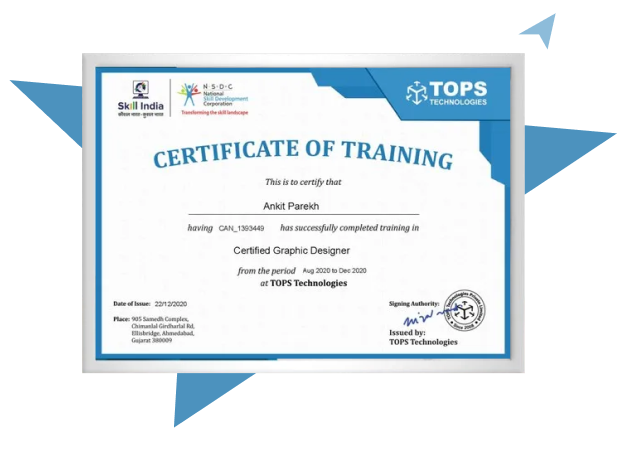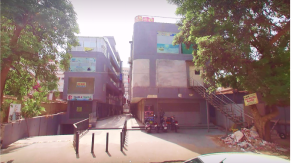Our Facts and Figures
1 Lac+
Student Placed
3000+
Companies TieUp
19+
Offices in India
50+
Industry Courses
Get 100% Job Assistance by enrolling in Certified Full Stack Training Course
Key Highlights
Limited Students Batch
Personalised Attention
Highly Qualified Teachers
Flexible Batch Timings
Interactive Learning
Live Projects
Career Support
Job Oriented Training
Full Stack Development Course Highlights
Full Stack Developer Course in Gandhinagar
The Full Stack Classes in Gandhinagar enable students to acquire unique skills required to build database-backed APIs and web applications. Once you complete full-stack training, you will be able to design and develop databases for software applications, create and employ database-backed APIs, and secure and manage user authentication and access control for an application. To know more about our full-stack course, get in touch with our nearest location or email us at inquiry@tops-int.com.
What is Full Stack Web Development
Full-stack web development involves in-depth computer system applications comprising both front-end and back-end development concepts. It includes the Presentation Layer (the front end), the Business Logic Layer (the backend), and the Database Layer. A full-stack developer works from the inception of a project to the launch of the final product.
Why Learn Full Stack Classes in Gandhinagar
Full Stack web development course opens doors to a lucrative career in the IT industry. Understanding the process of web development positions you ahead of developers familiar with only one side of the concept. In addition, a full-stack course is a critical element to landing a full-stack engineering job. As a full-stack developer, you handle the needs of an organization by offering creative solutions for user experience and helping businesses save time and money. With full-stack development certification, you become a go-to candidate for the back-end and front-end processes. There are plenty of high-paying career opportunities where full-stack training is useful:
- Software Developer
- Computer Systems Analyst
- Information Security Analyst
- IT Manager
- Computer Programmer
- Computer Network Architect
Why Choose Us for Full Stack Training Course In Gandhinagar?
Tops Technologies offers you an opportunity to work on real-world projects with immersive content built by expert full-stack developers. With our tailored full-stack course, you will master the tech skills most sought-after by top-tier companies. Our experienced mentors guide you through the learning process by focusing on a one-on-one teaching approach. Learn at your own pace and reach your personal goals to start or change the path to a successful career in the IT industry. We offer a comprehensive full-stack developer course with placement services.
Who Can Enroll in Our Full Stack Web Developer Course?
Our full-stack course is designed for:
- Computer science graduates
- Freshers looking to build a career in the IT industry
- Professionals looking to change their career path
- Candidates looking to acquire a full-stack developer course with certification
- Anybody willing to learn back-end and front-end web development
Enroll in Our Full Stack Training Course In Gandhinagar - Start Exploring Your Interests!
If you want to build your career as a full-stack developer, you need to learn from the best of the best in the industry. We at TOPS Technologies offer complete guidance and the opportunity to work on real-world projects with immersive content built by expert full-stack developers. Our Full Stack Web Developer Course is tailored to build and master your tech skills most sought-after by top-tier companies. At TOPS Technologies, we focus on a one-on-one teaching approach, allowing the learner to learn the matter in depth. Learn at your own pace and reach your personal goals to start or change the path to a successful career in the IT industry. We offer a comprehensive full-stack developer course with placement services.
For further inquiries regarding TOPS Technologies Full Stack Web Developer Course In Gandhinagar, reach out to us at inquiry@tops-int.com or call us at +91 – 7622011173 for a free demo. You can also learn Full Stack training in Ahmedabad, Vadodara, Gandhinagar, Nagpur, Rajkot, and Surat
40%
Average Salary Hike
4.5 Lacs
Highest Salary
3000+
Hiring Partners
Join Our Free Upcoming Webinar
How to Become a Data Scientist
17 Apr 2025, 04:00 PM
Trainer
Khushbu Birhade
(Sr. Technical Trainer)
Everything you need to know about Kotlin
18 Apr 2025, 02:00 PM
Trainer
Prakruti Vyas
(Sr. Technical Trainer)
Learn the Website Hacks and Provide Better Security
18 Apr 2025, 03:30 PM
Trainer
Faruk Pathan
(Sr. Technical Trainer)
Python Web Development
18 Apr 2025, 05:00 PM
Trainer
Anjali Patel
(Sr. Technical Trainer)
Career in Digital Marketing
19 Apr 2025, 12:00 PM
Trainer
Sanket Chauhan
(Sr. Technical Trainer)
Object-Oriented Programming in Java
19 Apr 2025, 01:30 PM
Trainer
Jigar Thakkar
(Sr. Technical Trainer)
MERN Stack: Build Your First Full-Stack App
19 Apr 2025, 03:00 PM
Trainer
Chintan Ring Road
(Sr. Technical Trainer)
Carrer in Graphic Designing
19 Apr 2025, 04:30 PM
Trainer
Saurabh Verma
(Sr. Technical Trainer)
IT Career Path - A Guide to Starting Your IT Career
20 Apr 2025, 11:00 AM
Trainer
Jigar Thakkar
(Sr. Technical Trainer)
Full Stack Development Course Curriculum
Download Curriculum- C Language – Control statements (if, . else statements , nested if statement , switch statement) ,looping statements (for, while ,do .. while)
- C++ : Oops concepts (class, objects, inheritance , polymorphism , data abstraction, encapsulation)
- Html 5, Tags, Input Forms
- Css3
- Sql
- CRUD operations queries
- Select statements
- Where clauses
- oin queries
- HTML-(1 session)Basic HTML like What is Tags attribute property Form Tag HTML-HTML5 tags
- CSS (1) Selectors • Margin-Padding-display property • Create login-registration page
- Bootstrap (2) Grid Rows-Cols • Forms-Cards
- SQL-(MySQLi)(4)
- SQL Queries
- Normalization
- Joins
- Indexer
- Practical Examples 1) MySQL data types 2)Create Multiple Tables and perform the queries using Select, Update, Delete, Insert Where, Like, Group By, Having, Limit, Offset, Sub Query and Or, Not, In 3) Function and procedure 4) Trigger 5) Views 6) Primary a
- PHP array
- PHP expression
- PHP function
- PHP operations
- String Function
- PHP String
- Practical Example: 1)Display the value of the array 2) To Find the number of odd and even element in array. 3) Create associative array for user detail and display the user detail. 4)shifted all the zero in bottom up of the array
- HTTP Protocol
- PHP syntax
- PHP variable
- Super Global Variables
- Practical Example: 1) Create Multiple Tables and perform the queries using Select,Update,Delete,Insert Where,Like,Group By,Having,Limit,Offset,Sub QueryAnd ,Or,Not,In
- Conditions Events and flows
- If condition
- If else if
- Practical Example : 1)Make Simple Calculator 2) Find the current day and if it is Sunday than print happy Sunday
- Practical Example: 1) Restaurant food Category Program using Switch case Display Which Category and dish user 2) Using Ternary display age if it is greater than 18 3)Display Name Of the color which user selected
- Do While Loop
- For each Loop
- For loop
- Practical Example : 1) Create a script that displays 1-2-3-4-5-6-7-8-9-10 on one 2) Create a script using a for loop to add all the integers between 0 and 30 and display the total. 3)Write a PHP script using nested for loop that creates a chess board 4)Al
- Array Function
- Date-time function
- Header function
- Include require
- Practical Example: 1) Perform all the 2)In user define function: 3)Create calculator 4)Find factorial using recursion 5)Reverse string without function 6) Download file on button click
- SDLC OOPS :Object Oriented Programing Class – object Inheritance Polymorphism Encapsulation Abstraction Aggregation
- SQL : Importance of Database CRUD JOIN QUERIES
- Front-End Fundamental : HTML , CSS , JavaScript , Jquery
- ViewBag,ViewData,TempData 2 MVC Life Cycle 3 Razor Controls
- State Management 5 JavaScript,Jquery,Ajax 6 Web Api
- EDM & LINQ & Net Differences practical
- OOPs Concepts
- Class
- Object
- Extends
- Overloading
- Abstraction interface
- Constructor
- Destructor
- Magic Methods
- Scope Resolution
- Traits
- Visibility
- Type hinting
- Final keyword
- Email security function
- File handling
- Handling emails
- MVC Architecture
- Practical Example: Implementation of all the Oops Concept
- Connection with MySQL database
- SQL injection
- Practical : 1) Take Project Definition 2) Exception handling with try catch for database connection and all 3) Server- side Validation while Registration using Regular expressions. 4) Send mail while registration
- Session and cookies
- File upload
- PHP with MVC Architecture
- Insert, Update, Delete MVC
- Practical Example: 1) Apply session cookies concepts 2) File uploading and downloading 3) Bootstrap data-table Pagination
- Java script
- JQuery
- JQuery Events
- JQuery Validation
- Practical Example: 1)Alert, Prompt, Confirm 2)Create calculator 3)Create slideshow 4)Validation using JavaScript 5)Hide show using jQuery
- PHP and Ajax
- AJAX (crud)
- Regular Expression
- Practical Example :1) Event Examples (Onblur,onkeypres) 2)Regular expression 3) Create dependent drop down Pagination using ajax jQuery in MVC Project Insert Files using Ajax
- Payment Gateway Integration
- -> Create API With Header -> API with Image Uploading
- Practical Example: Payment Gateway Implement on MVC Project
- -> SOAP and REST AP, Create API for insert, update and delete
- Product Catalog
- Shopping Cart
- Web Services
- Practical Example: Create Web Services for MVC Project Integration of API in Project
- Installing Laravel
- Artisan CLI ( command-line interface )
- Laravel Directory Structure
- Configuring a new Laravel project
- Artisan command to generate boilerplate code for a controller
- Basics of laravel—— > Routing
- Controller
- Middleware
- Request
- Response
- HTML Template to Laravel Blade Template
- HTML Template to Laravel Blade Template———- > Template inheritance
- Master layout
- Extending the master layout
- Displaying variables
- Blade conditional statements
- Blade Loops
- Executing PHP functions in blade
- Displaying Your Views
- Creating and using a basic views
- Loading a view into another view/nested views
- Adding assets Integrating with Bootstrap
- Introduction
- Requirements for running migrations
- Artisan migration command
- Migration structure
- How to create a table using a migration
- Laravel migration rollback
- Database Seeding
- Migrations for our project database Pagination
- Creating contact us form
- Validating user input
- Sending email
- Creating a file uploader
- Validating a file uploader
- Creating a custom error message
- Laravel Collective—— > Installation
- Opening A Form
- Form Model Binding
- Form controls
- Custom macros
- Introduction
- Creating a basic controller
- Creating a route using a closure
- Making the controller RESTful
- Using route groups
- Building a RESTful API with routes
- Rest API with Passport Authentication
- Event
- Queue
- Task Scheduling
- Eloquent ORM and Models—— > Naming conventions
- Table name and primary keys
- Timestamps
- Eloquent ORM INSERT, READ, UPDATE, DELETE
- Relationship
- Using models in controllers
- Displaying data from models in views
- Creating and Using Composer Packages———- > Downloading and installing packages
- Using a basic Shopping Cart package in our project
- socialite
- Using Ajax and jQuery—– > Getting data from another page
- Setting up a controller to return JSON data
- Creating a Jquery, AJAX comment system
- Security & Session—— > Using Security Sessions Effective
Our TOPS Training Centers in India
Course Key Features
Skills Covered
Job Roles
Get Training Certificate by Government
Recognized NSDC/Skill India

- National Skill Development Corporation
- Supported by the vision of PM Shri Narendra Modi
- Certification by NSDC SkillIndia
- Valid for all Jobs and College Training
- International Recognition

Interview Questions
Docker is an open-source containerisation tool used in full-stack development to construct, distribute, and maintain portable and consistent applications. It allows developers to bundle a programme and its dependencies into a container that can be executed on any platform that supports Docker.
In full-stack development, Docker builds a standardised environment for apps, making managing dependencies simpler and assuring consistent performance across several platforms. Since containers may be readily transferred between development, testing, and production environments, it helps developers rapidly construct and deploy applications.
It further simplifies deployment by removing the requirement for the manual setup of servers and dependencies. Docker allows developers to specify their application's environment and dependencies in a single file, making it simpler to manage and change over time.
The serverless architecture cloud computing concept allows developers to construct and execute apps without managing servers or infrastructure. It enables developers to concentrate on creating code rather than maintaining servers, reducing development expenses and time.
Here are a few significant facts concerning serverless architecture and its use in full-stack development:
Serverless Architecture: Serverless architecture is founded on Function-as-a-Service (FaaS), in which developers create functions performed on demand in response to events or triggers. The cloud service provider handles the underlying infrastructure, scaling up or down the resources as necessary.
Advantages: Serverless architecture may save development time and costs, improve scalability, and enhance flexibility. In addition, it allows developers to concentrate on developing code rather than maintaining servers.
Use Cases: Serverless architecture is ideal for applications with unexpected or irregular traffic patterns, such as mobile or IoT apps, and applications that demand real-time data processing or event-driven processes.
Implementation: Serverless architecture may be deployed utilising cloud platforms like AWS Lambda, Microsoft Azure Functions, and Google Cloud Functions.
Synchronous programming is a programming paradigm in which each job is completed sequentially. This implies that one job must be finished before the next can begin, possibly resulting in longer execution times.
On the other hand, asynchronous programming allows activities to be run concurrently without waiting for one to finish before beginning the next. This leads to speedier execution speeds and greater resource efficiency.
Asynchronous programming is often used in web development to handle activities involving I/O operations, such as retrieving data from an API or reading server-side files. Developers may increase the responsiveness and speed of their apps by using asynchronous programming.
Event-driven programming is a paradigm of programming in which system events, such as user input or system events, govern a programme's flow. It is used to construct real-time applications because it allows programmers to write code that reacts to events as they occur.
Full-stack development uses event-driven programming to create applications requiring real-time updates or event-driven processes, such as chatbots, gaming, and analytics. It may be implemented using a variety of frameworks and technologies, including Node.js and WebSockets, which allow real-time client-server communication.
Scalability is the capacity of a system to accommodate an increase in workload or traffic without degrading performance. Scalability is critical in full-stack development to ensure that web applications can accommodate rising users and data.
Here are a few essential facts on the significance of scalability in full-stack development:
User Experience: Scalability is essential for delivering a pleasant user experience. The programme must accommodate an increase in the number of users or the quantity of data without slowing down or crashing.
Business Growth: The application must be able to manage increased traffic and data as a company expands; otherwise, the firm will be unable to keep up with demand.
Performance: Scalability may also boost an application's performance. By dividing the workload over numerous servers or instances, the application can simultaneously process more requests, resulting in better response times.
Latest Blogs
Transitioning into Full Stack Development: A Caree...
Embarking on a career in full-stack development offers a rewarding pathway in the tech world. Whethe...
View full BlogHow can I switch from front-end to full stack deve...
On the other hand, Full Stack Development is a broader domain that covers both the front-end and bac...
View full BlogFull Stack Developer Interview Questions
By investing your time in these Full Stack Interview Questions and Answers, you're not just preparin...
View full BlogRoadmap To Become a Full Stack Developer & The Bes...
A full stack development course in Ahmedabad can be a game-changer, particularly in India, where the...
View full Blog








